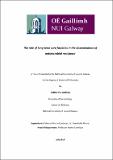| dc.contributor.advisor | Morris, Dearbhaile | |
| dc.contributor.advisor | Cormican, Martin | |
| dc.contributor.author | Ludden, Catherine | |
| dc.date.accessioned | 2014-11-17T11:17:45Z | |
| dc.date.available | 2015-05-01T10:55:42Z | |
| dc.date.issued | 2014-11-05 | |
| dc.identifier.uri | http://hdl.handle.net/10379/4732 | |
| dc.description.abstract | The dissemination of antimicrobial resistant organisms (AROs) is recognised as a global problem in healthcare-settings and in the community. There is limited data on the role long-term care facilities (LTCF) play in the spread of AROs and risk factors for acquisition in this vulnerable population. This Ph.D. was performed to address these issues and the findings are presented as five publications (I-V).
Paper I describes the comparison of ESBL-producing E. coli (ESBL-EC) collected from LTCFs, hospitals and the community in 2010. This paper supports clonal dissemination of E. coli ST131 in the West of Ireland, particularly in LTCFs. Paper II provides evidence of surface contamination with MRSA in a LTCF preceding occupation by residents, but concurrent with commissioning the facility by staff, and more widespread contamination of MRSA in the LTCF after occupation by residents in 2011. A selection of MRSA isolates recovered from the environment (2011-2013) and residents (2013) of a LTCF were further investigated by genotypic analysis (Paper III). The results described in Paper III illustrate a PVL-negative spa clonal group (spa-CC22), associated with ST22, predominating in both environmental and clinical isolates. The findings from Papers IV and V demonstrate a high prevalence (>50%) of ESBL-EC colonisation among LTCF residents over a one year period, which is attributed to the clonal spread of the ST131 H30-Rx subclone. The main risk factors identified for the acquisition of this subclone include antimicrobial usage and residents highly dependent on care by healthcare staff. Similar risk factors were reported for MRSA acquisition and a lower prevalence of MRSA colonisation in the LTCF was identified (>25%).
This Ph.D. research enhances our understanding of the role LTCFs play in the dissemination of AROs illustrating environment contamination with MRSA and a high prevalence of ESBL-EC and MRSA attributed to clonal dissemination in LTCFs. | en_US |
| dc.rights | Attribution-NonCommercial-NoDerivs 3.0 Ireland | |
| dc.rights.uri | https://creativecommons.org/licenses/by-nc-nd/3.0/ie/ | |
| dc.subject | Extended-spectrum beta-lactamase (ESBL) | en_US |
| dc.subject | ST131 | en_US |
| dc.subject | Discipline of Bacteriology | en_US |
| dc.subject | Carbapenemase-producing Enterobacteriaceae (CPE) | en_US |
| dc.subject | Environment | en_US |
| dc.subject | Long-term care facilities | en_US |
| dc.subject | Vancomycin-resistant enterococci (VRE) | en_US |
| dc.subject | Meticillin-resistant S. aureus (MRSA) | en_US |
| dc.title | The role of long-term care facilities in the dissemination of antimicrobial resistance | en_US |
| dc.type | Thesis | en_US |
| dc.local.final | Yes | en_US |
| nui.item.downloads | 3269 | |


